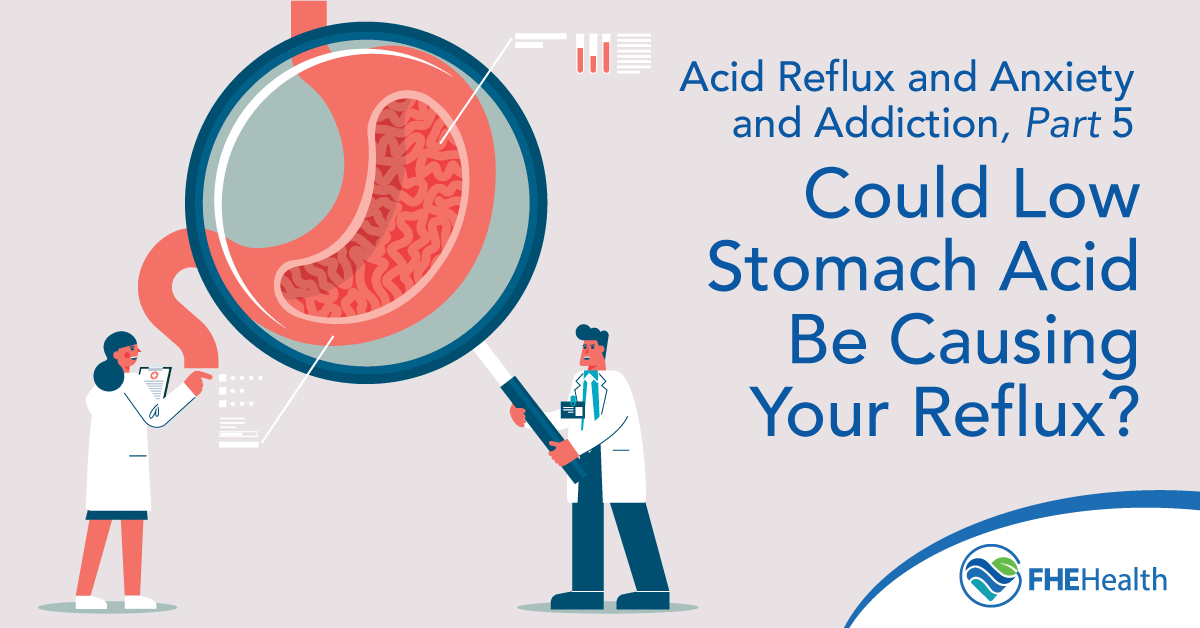
In Part 5 of our reflux series, we’re exploring a surprising cause of acid reflux that often goes overlooked: low stomach acid.
While reflux is usually blamed on too much acid, some people actually have too little. Without enough acid, food isn’t properly broken down, which can lead to fermentation, gas, delayed stomach emptying, and pressure that pushes contents back into the esophagus.
In this post, we’ll explain how low stomach acid causes reflux, who is most at risk, and what steps you can take to support healthy digestion and long-term healing.
How Can Low Stomach Acid Cause Reflux?
Our stomach is supposed to become highly acidic when we eat. This acidity activates enzymes that help break down our food and also signals to the rest of the digestive system to begin the next stages of digestion.
Research shows that when the stomach doesn’t reach a low enough pH, several problems can occur. Protein digestion becomes impaired (27), and the absorption of key nutrients such as vitamin B12, iron, and zinc is reduced (1). Low stomach acid can also delay gastric emptying (2-3, 28), allowing food to remain in the stomach longer than it should. This delayed emptying increases pressure in the stomach, which can trigger the relaxation of the lower esophageal sphincter (LES) and allow stomach contents to flow upward, resulting in reflux (a process explained earlier in this series).
Think of your stomach like a cooking pot on the stove. When the heat is high enough, the ingredients cook properly, and everything gets broken down smoothly. But if the heat is too low, the food just sits there, undercooked and starting to spoil. Gases begin to build up, and eventually, the pressure pushes the lid of the pot up and spills some of the contents out.
That’s what happens in your stomach when acid levels are too low. Food isn’t digested efficiently, gas builds up from fermentation, and that pressure pushes against the valve that normally keeps food in the stomach. If that valve opens, the contents can rise back up into the esophagus, causing reflux.
Who has low stomach acid?
Research shows that people over the age of 65 are more prone to low stomach acid. Specifically, one study showed that it took the stomach more than twice as long (over 45 minutes longer) to reacidify compared to younger people. Furthermore, 20 percent of the older adults were never able to get the pH down to 2, a level of acidity that is important for protein digestion in the stomach (1). If the contents leaving the stomach are not acidic enough, the digestive hormones may not be properly activated. This can disrupt the signaling to the pancreas and liver-gallbladder system, leading to reduced secretion of enzymes and bile needed for digestion. This can ultimately contribute to reflux and other gastrointestinal issues.
Zinc deficiency can contribute to low stomach acid (4), and since poor diet is common among individuals with substance use disorders, this deficiency may be an overlooked cause of acid reflux in active addiction. Alcohol abuse further compounds the issue by damaging the stomach’s acid-secreting cells (6-7). This represents another underlying cause of reflux in people with addiction and those in recovery, and it requires a different intervention to support true healing. Zinc supplementation has been shown to increase acid secretions (5) and repair stomach lining (8-9).
Somewhat paradoxically, PPIs can lower stomach acid (and delay gastric emptying) to such a degree that they worsen the very reflux symptoms they are intended to relieve (10). Chronic stress is another factor that can suppress stomach acid production by disrupting vagal nerve signaling (11). Additionally, long-standing Helicobacter pylori infection is a known cause of low stomach acid (12). Another important, though less common, cause is autoimmune gastritis. This condition occurs when the immune system attacks the parietal cells responsible for acid secretion. People with autoimmune diseases such as Hashimoto’s thyroiditis, type 1 diabetes, celiac disease, and especially pernicious anemia (29) are at significantly higher risk of developing autoimmune gastritis (13). If you have one of these conditions, it is worth considering that your reflux symptoms may actually stem from low stomach acid rather than too much.
Those who experience acid reflux symptoms after eating refined carbohydrates, such as sugary foods and white flour, may actually have low stomach acid. Low stomach acid weakens the body’s natural defense against microbes, allowing bacteria and yeast to overgrow (15–16). These microbes ferment carbohydrates into acetaldehyde, a toxic compound that causes inflammation, damages the mucosal lining of the stomach and esophagus (9,14), and may impair acid-secreting cells while increasing tissue sensitivity to acid. Fermentation also produces gas, which increases pressure on the lower esophageal sphincter and can push stomach contents into the esophagus. While large amounts of sugar can trigger reflux through various mechanisms, when symptoms occur with typical portion sizes, low stomach acid and microbial imbalance are more likely to be the underlying causes.
Strategies to Support or Restore Stomach Acid Production
1. Betaine HCl with pepsin (17)
This directly provides what the stomach is lacking. Start low and increase gradually under practitioner supervision.
2. Premier Research Labs HCl and HCl Activator
A vegan-friendly alternative to standard HCl supplements.
Important note on NSAIDs and steroids: It’s best to avoid taking HCl while using NSAIDs or corticosteroids. These medications can damage the stomach lining or reduce its natural protective mechanisms, making you more likely to experience irritation, burning, or pain if acid is added. However, once you are off these medications and have supported healing of the mucosa (for example with zinc carnosine, DGL, and dietary changes), you may be better able to tolerate and benefit from HCl supplements if you have low stomach acid.
3. Bitters (18)
Bitters stimulate gastric secretions and can be enough for some individuals. They can also be used in combination with HCl products.
4. Apple Cider Vinegar (ACV)
Anecdotally helpful for some, but not supported by research. Try 1 tsp in 1/3 cup water with meals (with a straw to protect teeth). Stop if it worsens symptoms.
5. Stress management and vagus nerve stimulation
Low vagal tone reduces stomach acid. Support this with:
- Deep breathing (19)
- Meditation (20)
- Eating slowly in a calm environment
- Non-invasive vagus nerve stimulating device (21-22)
- YouTube search exercises for supporting the vagus nerve. There are a ton!
6. Adequate zinc intake and supplementation if needed
Zinc deficiency can impair stomach acid production (4), and zinc supplementation has been shown to help restore it (5). Oysters are by far the most concentrated food source of zinc. Other good dietary sources include beef, liver, hemp seeds, pumpkin seeds, and lentils. For supplementation, zinc carnosine is a highly bioavailable form that not only supports zinc status but also promotes healing of the gastric lining (8-9). By repairing mucosal damage, it may help restore the function of acid-secreting cells, particularly in cases where inflammation or irritation has compromised their activity.
7. Proper chewing and mindful eating
Thorough chewing and eating without distraction support natural cephalic-phase digestion.
8. Address H. pylori
H. pylori is a persistent and difficult-to-eradicate infection. Conventional treatment usually involves triple therapy, which includes two antibiotics and a proton pump inhibitor. Even with this approach, success rates are only around 80 percent, and antibiotic resistance is increasing. While there is currently no research supporting a standardized “triple natural therapy,” several herbs have shown anti–H. pylori activity in studies, though their success rates are also modest when used alone.
One promising option is black cumin seed powder, which was shown in one study to be nearly as effective as standard triple therapy when taken at 1 gram twice daily (23). If your provider is open to it, a more comprehensive integrative approach may include black cumin seed powder, an anti-inflammatory diet, probiotics (26), and a supplement like Orthomolecular Pyloricil or another herbal combination targeted at H. pylori. This could be considered a “natural triple therapy” model.
If this approach is not successful, combining conventional triple therapy with bismuth or supportive botanicals has been shown to improve eradication rates compared to triple therapy alone and may be a next step (24-25).
Avoid long-term PPI use unless clearly indicated.
If you have an autoimmune condition, it is even more important to focus on an anti-inflammatory diet. Consider an elimination diet to identify any food sensitivities that may be contributing to inflammation, such as gluten and dairy, and be proactive in supporting overall gut health.
9. Test for low stomach acid
Stomach acid can be evaluated by your gastroenterologist.
Treatments to Address Secondary Issues Caused by Low Stomach Acid
When stomach acid is chronically low, it can lead to nutrient deficiencies, microbial overgrowth, and mucosal damage. These secondary issues also need to be addressed:
1. Vitamin B12 supplementation
Long-standing low stomach acid impairs B12 absorption. Supplement with sublingual or intramuscular B12 as needed. Consider using the methylcobalamin or hydroxocobalamin forms, which may be better absorbed and utilized by the body.
2. Zinc carnosine and L-cysteine (9, 14)
- Zinc carnosine helps heal the gastric lining and may support acid-producing cells.
- L-cysteine binds and neutralizes acetaldehyde, a toxin produced when there is an overgrowth of certain bacteria and yeast. This overgrowth can occur in the stomach when there is not enough stomach acid to keep microbial populations in check.
3. Probiotics and oral hygiene
These help reduce acetaldehyde production by rebalancing oral and gut microbes that ferment sugars and produce ethanol.
4. Dietary changes to reduce fermentation
A high-sugar or high-refined-carb diet fuels microbes that produce acetaldehyde and gas, worsening reflux. Emphasize:
- Low-sugar, anti-inflammatory meals
- Temporarily remove other fermentable foods if you notice symptoms after eating them, especially while treating SIBO or another root cause. This may include onions, garlic, broccoli, cauliflower, and other high FODMAP foods.
5. Treat SIBO or fungal overgrowth (15)
Low stomach acid can contribute to microbial overgrowth in the small intestine. Treating SIBO and preventing recurrence is complex and often requires a personalized approach. It is best to work with a knowledgeable healthcare provider to ensure appropriate testing, treatment, and long-term support.
6. Digestive enzymes (optional)
Low acid impairs pancreatic stimulation. In some cases, short-term use of enzymes may help with fat and protein digestion.
Closing Thoughts
As we have discussed in this post and throughout the series, there are many different underlying causes of reflux. Low stomach acid is just one piece of a much larger puzzle. For some, addressing acid levels may be the missing link. For others, treating microbial overgrowth, nutritional deficiencies, or immune-related inflammation may be just as important. This series highlights the need for a more nuanced and personalized approach to GERD that moves beyond symptom suppression and focuses on identifying and treating the root causes of reflux.
Stay tuned for Part 6, where we will continue exploring additional contributors to reflux and evidence-based strategies to support long-term digestive health.






